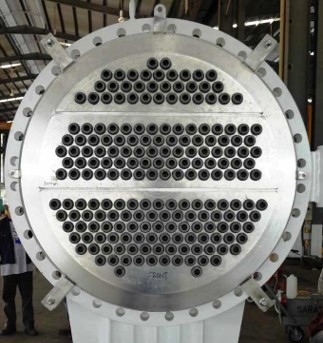Liquid Desander – Operating Boundaries (B-FSM071)

This article will address the operating boundaries for the liquid (produced water) desander. These boundaries are categorized into Fluids and Pressure (hydrodynamics), Solids and Particles, and Application and Operation. The focus is on small diameter, multi-liner desanders used in liquid-only (not multiphase) flow. This information captures that presented in posts B-FSM-042 to -070.
Fluids and Pressure
Pressure Drop
- Minimum 3-5 psid based on liner diameter (see post B-FSM-057 of 16-Oct-18)
- Maximum set at 50 psid for wear life
Flow Conditions
- Designed for no free gas (up to <5% GVF may be tolerated on occasion)
- Turndown: 3:1 per liner, >100:1 by physical change-out of liners w/ blanks
- Can segment vessel to PACS design to automate turndown of 20:1 (see header photo)
Slugging
- Must stay within pressure drop range (see post B-FSM-061 of 13-Nov-18)
Fluid Viscosity
- Avoid liquid with high liquid viscosity (>100 cP) (see post B-FSM-058 of 23-Oct-18)
Solids and Particles
Particle Size
- Maximum 1/3 smallest opening on insert (inlet or apex)
- 38 mm (1.5”) liner: 1.0 mm max particle size
- 75 mm (3.0”) liner: 2.5 mm max particle size
Particle Concentration
- Static operation based on apex flux limits (see posts B-FSM-066 to -069)
- Example: 150-micron sand in water
- 38 mm (1.5”) liner: 1500 ppmw (0.15%) max concentration
- 75 mm (3.0”) liner: 2500 ppmw (0.25%) max concentration
- Implementation of Apex Flux Balancing increases limit by order of magnitude
- Accumulator volume and rate of isolation/discharge will be limiting factory at high solids concentration (see post B-FSM-053 of 14-Aug-18)
Application and Operations
Applications
- Traditionally produced water treatment directly off production separator and before deoiler hydrocyclone
- Can be used in any liquid stream with solids present
Utilities
- Flush/fill secondary accumulator (clean water any source at 50 psig)
Consumables
- Liner replacement and o-rings
Process Connections
- Standard (four total): inlet, clean fluid outlet, solids discharge, and accumulator-flush/fill
The next article will discuss mechanical requirements for liquid desanders.
References:
- Ditria, J.C., Hoyack, M.E., “The Separation of Solids and Liquids with Hydrocyclone-Based Technology for Water Treatment and Crude Processing”, paper 28815, SPE Asia Pacific Oil & Gas Conference, Melbourne, Australia, 7-10 November 1994.
